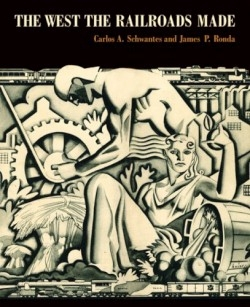The West The Railroads Made
Bold entrepreneurs, big visions, daring engineering, great scenery, a huge new economy, and sweeping social change are among the elements that Carlos Schwantes and James Ronda masterfully describe in their exuberant and lavishly illustrated volume. The “Pacific railroad” was a fine, much-discussed dream, but hard reality required immense projects, armies of settlers, and endless revenue; in 1848, Asa Whitney, in stating, “I propose, by this work itself, to change the wilderness waste to cities, villages, and richly cultivated fields,” announced a hope and foretold an outcome. But, in the event, Huntington, Hop-kins, Stanford, and Crocker, whose names live on in California, were the builders. And, of course, the spread of the railroads trans-formed the West, confronting nature, adding (and occasionally removing) physical features, and also, through imaginative publications, marketing an unknown half of the American continent.
The authors’ narrative demonstrates that the railroads achieved nothing less than a revolution, powerfully shaping the development of Chicago, St. Louis, Seattle, and other cities, and dealing a blow to steam navigation as well as river and canal transportation, leading the way for telegraph lines and the demise of the Pony Express, and changing the nation’s time-keeping habits with “railway time.”
Reviewed by
Peter Skinner
Disclosure: This article is not an endorsement, but a review. The publisher of this book provided free copies of the book to have their book reviewed by a professional reviewer. No fee was paid by the publisher for this review. Foreword Reviews only recommends books that we love. Foreword Magazine, Inc. is disclosing this in accordance with the Federal Trade Commission’s 16 CFR, Part 255.

